Create successful ePaper yourself
Turn your PDF publications into a flip-book with our unique Google optimized e-Paper software.
<strong>Blue</strong> <strong>tit</strong><br />
● Colour in this great <strong>mask</strong> to look like a blue <strong>tit</strong>.<br />
● Look at the guide to see which colours should go where.<br />
● Where we haven’t marked a colour, leave it white.<br />
Turn over for more instructions on how to complete<br />
your <strong>mask</strong>.<br />
Pinch fold<br />
= fold<br />
= cut<br />
Fold<br />
Yellow<br />
Colouring guide<br />
<strong>Blue</strong>
What you need:<br />
<strong>Blue</strong> and yellow<br />
coloured pencils or<br />
felt pens<br />
Scissors<br />
About 50 cm of<br />
shirring elastic<br />
Sticky tape<br />
What to do:<br />
● Colour in your <strong>mask</strong>, following the guide<br />
● Carefully cut out your <strong>mask</strong> and the beak, following the thick line marked with scissors.<br />
● Even more carefully, cut out the eyes and cut the two slits between the eyes.<br />
● Ask an adult to help you push out the holes marked (two each side), ready to thread<br />
the elastic.<br />
● Fold the <strong>mask</strong> in half along the dotted lines.<br />
● Crease along the dotted lines on the bird’s forehead.<br />
● Fold the beak in half along the dotted lines.<br />
● Push the beak flaps through the slots and stick to the back with sticky tape.<br />
● Thread the elastic through the holes from the back of the <strong>mask</strong> and stick it to the back<br />
with sticky tape. To make it stronger, tie knots in the ends before you stick them down.<br />
<strong>Blue</strong> <strong>tit</strong><br />
<strong>Blue</strong> <strong>tit</strong>s are small and light, and very good acrobats. This helps them hang<br />
upside down on the thinnest twigs to look for food.<br />
Although blue <strong>tit</strong>s often come to gardens to feed and nest, they are really<br />
woodland birds. Oak trees are their favourite places because they have<br />
plenty of caterpillars and other insects to feed to their chicks.<br />
www.rspb.org.uk/youth<br />
<strong>RSPB</strong> Wildlife Explorers is the junior<br />
membership of The Royal Society for the<br />
Protection of Birds.<br />
Registered charity no 207076<br />
36-1435-02-03

















